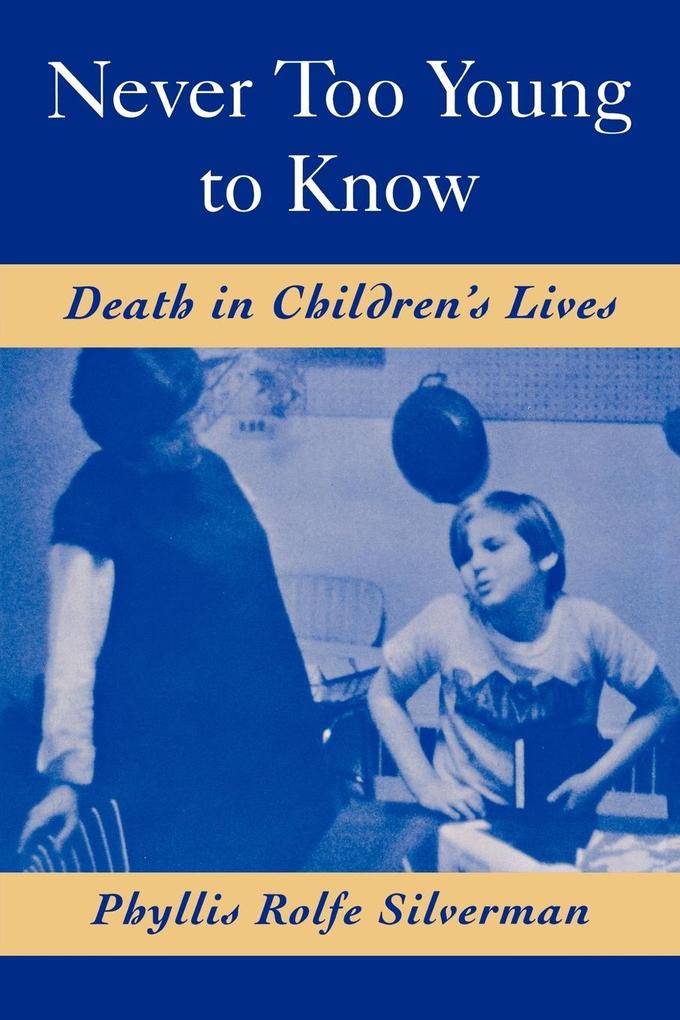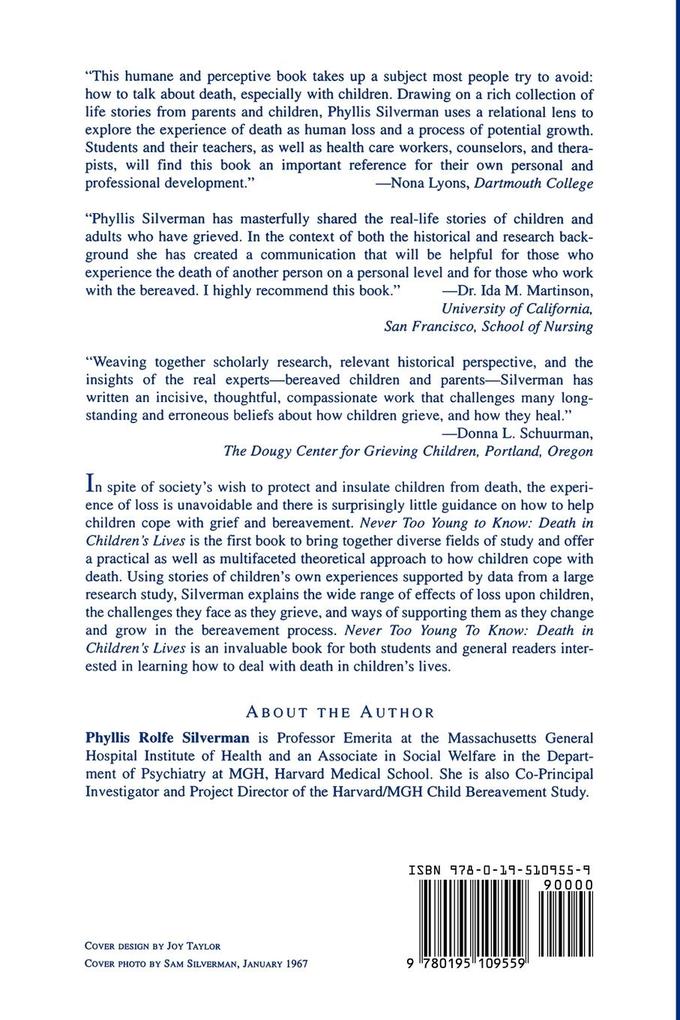
Zustellung: Do, 24.07. - Mo, 28.07.
Versand in 5 Tagen
VersandkostenfreiBestellen & in Filiale abholen:
Never Too Young To Know is the first book to bring together diverse fields of study and offer a multifaceted theoretical approach to how children experience death. Using stories of children's own experiences supported by data from a large research study, Silverman explains the wide range of effects of loss upon children, the challenges they face as they grieve, and ways of supporting them as they change and grow in the bereavement process. This book is suitable for Social Work courses dealing with children at the upper level undergraduate/graduate level, Psychology courses dealing with death and dying and the family at the same level of students, and school and pastoral counseling courses. In addition, this book has a wider audience in general, readers who are dealing with death in their children's lives as well.
In spite of society's wish to protect and insulate children from death, the experience of loss is unavoidable and there is surprisingly little guidance on how to help children cope with grief and bereavement. Never Too Young to Know: Death in Children's Lives is the first book to bring
together diverse fields of study, offering a practical as well as multifaceted theoretical approach to how children cope with death. Using stories of children's own experiences supported by data from a large research study, Silverman explains the wide range of effects of loss upon children and the
challenges they face as they grieve. Silverman presents grief as a normal part of the life cycle, which results not only in pain and sadness but also in change and growth. She further explains that children can and do cope effectively with loss and the changes it brings as long as they are taught to
understand that death is a part of life and that they will be included appropriately in the family drama.
Never Too Young To Know: Death in Children's Lives is divided into three parts. The first section includes an overview and theoretical framework that examines the social, historical, developmental, and familial forces that frame and focus children's lives as they experience loss. The second section
offers a detailed analysis of how children experience mourning different types of death including the death of siblings, parents, and friends, and death due to illness, suicide, accidents, and violence. The final section includes an accessible guide to helping children cope with grief, emphasizing
the importance and the necessity of social support as children learn to adapt to their newlives.
Never Too Young To Know: Death in Children's Lives is not only ideal for advanced undergraduate and graduate students learning about children but it is also useful for courses on death and dying and the family. It is also an invaluable book for mental health practitioners, cler
together diverse fields of study, offering a practical as well as multifaceted theoretical approach to how children cope with death. Using stories of children's own experiences supported by data from a large research study, Silverman explains the wide range of effects of loss upon children and the
challenges they face as they grieve. Silverman presents grief as a normal part of the life cycle, which results not only in pain and sadness but also in change and growth. She further explains that children can and do cope effectively with loss and the changes it brings as long as they are taught to
understand that death is a part of life and that they will be included appropriately in the family drama.
Never Too Young To Know: Death in Children's Lives is divided into three parts. The first section includes an overview and theoretical framework that examines the social, historical, developmental, and familial forces that frame and focus children's lives as they experience loss. The second section
offers a detailed analysis of how children experience mourning different types of death including the death of siblings, parents, and friends, and death due to illness, suicide, accidents, and violence. The final section includes an accessible guide to helping children cope with grief, emphasizing
the importance and the necessity of social support as children learn to adapt to their newlives.
Never Too Young To Know: Death in Children's Lives is not only ideal for advanced undergraduate and graduate students learning about children but it is also useful for courses on death and dying and the family. It is also an invaluable book for mental health practitioners, cler
Inhaltsverzeichnis
- Acknowledgments
- Preface
- Introduction
- Part I: Making Meaning of Death and Grief
- Introduction
- 1: Historical and Theoretical Perspectives
- 2: Bereavement: A Time of Changing Relationships and Transition
- 3: Grieving and Psychological Development
- 4: Children in the Family Context
- Concluding Thoughts to Part I
- Part II: Stories People Tell
- Introduction
- 5: The Death of a Parent: Dealing with Bad News, My World Is Turned Upside Down
- 6: The Death of a Parent: Making an Accommodation
- 7: My Child is Dying
- 8: After a Child's Death: Nothing is the Same
- 9: When a Sibling Dies
- 10: Invisible Mourners: The Death of a Friend
- Part III: On Helping
- Introduction
- 11: Help Over Time: Meeting Changing Needs
- 12: Finding Help: Services for the Bereaved
- 13: Teachable Moments: Promoting Competence
- Afterword
- Bibliography
- Appendix: Resources for the Bereaved
Produktdetails
Erscheinungsdatum
01. August 1999
Sprache
englisch
Seitenanzahl
288
Autor/Autorin
Phyllis Rolfe Silverman
Verlag/Hersteller
Produktart
kartoniert
Gewicht
442 g
Größe (L/B/H)
234/156/16 mm
ISBN
9780195109559
Entdecken Sie mehr
Pressestimmen
"It will be of great value to those who work with children ... I am very glad to add it to my bookshelf"Bereavement Care
Bewertungen
0 Bewertungen
Es wurden noch keine Bewertungen abgegeben. Schreiben Sie die erste Bewertung zu "Never Too Young to Know" und helfen Sie damit anderen bei der Kaufentscheidung.










